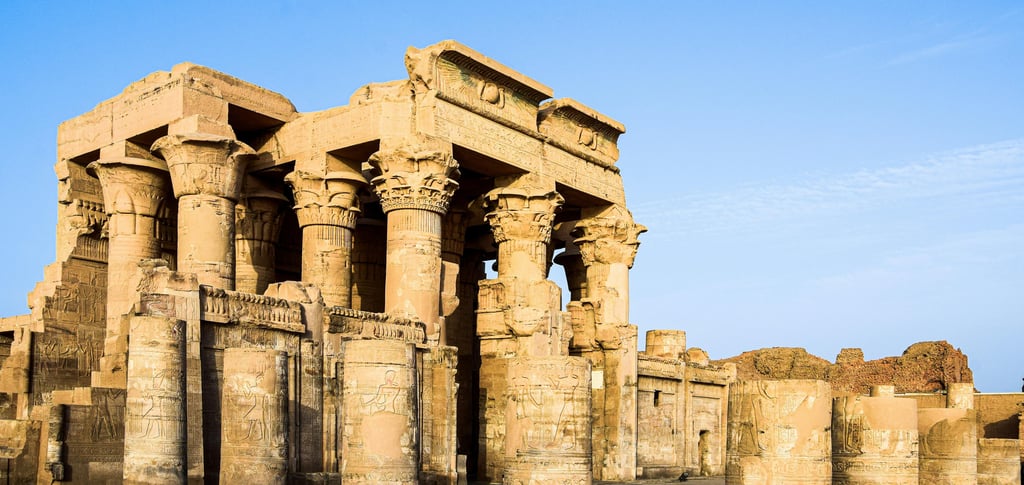Nile River Boat Tour to Kom Ombo Temple
Experience the tranquility of the Nile River on a captivating boat tour to Kom Ombo. Discover the ancient temple town surrounded by stunning desert landscapes and soak in the warm Egyptian sun.
4/7/20255 min read


Setting Sail on the Nile
As the sun began to rise over the horizon, casting a warm golden glow across the tranquil waters of the Nile, I found myself awash in a sense of anticipation. The gentle lapping of the river against the hull of our boat served as a soothing soundtrack, each ripple whispering tales of an ancient civilization that flourished along its banks. The Nile, often referred to as the lifeblood of Egypt, is more than just a river; it is a stunning tableau of history, culture, and spirituality intricately woven into the fabric of daily life.
As my journey commenced, I marveled at the enchanting landscapes that unfolded before me. The verdant green banks contrasted sharply against the vast expanse of the golden desert, with palm trees standing tall and proud, a vivid reminder of the natural beauty shaped by the Nile over millennia. Fishing boats, with their colorful sails flapping gently in the morning breeze, appeared like brush strokes on a vast canvas, bringing life and vibrancy to the scene. I inhaled deeply, embracing the distinct scent of the water mingled with the soft aroma of earth and sun.
The atmosphere on the Nile is undeniably unique; it is both serene and invigorating, as if the very essence of ancient Egypt permeates the air. Thoughts drifted to the generations that have gazed upon these same waters, their lives intimately connected to the river that sustains them. Known for its significance in Egyptian mythology and daily existence, the Nile has served as a crucial artery for trade, agriculture, and transportation, shaping the identity of the region.
As we glided closer to Kom Ombo, I felt a profound connection to both the past and the present, a realization that the Nile continues to be a powerful witness to the stories of those who have walked its banks. Each moment on this river was an invitation to reflect on the enduring legacy of Egypt, and the excitement bubbling within me grew as I anticipated the destination that lay ahead.
The Arrival at Kom Ombo
As I approached Kom Ombo, the golden hues of the sunset painted the sky, illuminating the ancient landscape with a warm glow. The temple complex, a magnificent structure dedicated to both the falcon god Horus and the crocodile god Sobek, rose majestically in the distance. Standing before this monumental site, I was struck by its architectural grandeur, characterized by towering columns adorned with intricate carvings and hieroglyphs that have endured the test of time. Each stone seemed to whisper stories of an era long past, stories that echoed through the now tranquil surroundings.
The ambiance created by the golden light accentuated the temple's details, bringing to life the artistry of the ancient Egyptians. The vibrant colors etched into the stone were remarkably preserved, revealing scenes of deities, rituals, and the daily lives of the Nile’s inhabitants. As I stepped closer, the grandeur of Kom Ombo became more evident; the symmetry of the temple layout, with its dual sanctuaries, was a striking feature that emphasized the complexity of ancient Egyptian beliefs. Here was a place where two gods were honored together, reflecting the ancient civilization’s reverence for the natural world.
Historically, Kom Ombo held strategic importance along the Nile River. It served as a vital trading hub and religious site, where pilgrims journeyed to pay homage to the gods. As I stood on the temple grounds, I pondered the significance of this location in ancient Egyptian civilization. The juxtaposition of the temple’s historical weight against the serene flow of the Nile underscored the extraordinary blend of natural and man-made beauty that defines Egypt. My awe deepened as I realized I was walking through history, in a site that has captivated humanity for millennia.
Exploring the Temple of Kom Ombo
Nestled on the banks of the Nile, the Temple of Kom Ombo stands as a remarkable testament to ancient Egyptian architecture and spirituality. Uniquely dedicated to two deities, Sobek, the crocodile god, and Horus the Elder, this temple embodies the duality of Egyptian beliefs. The temple’s symmetrical design, divided into two halves, reflects the balance of power and significance that each god held in the lives of the ancient Egyptians. Visitors are greeted by intricately carved reliefs, which depict a variety of scenes that range from daily life to ceremonial practices associated with the worship of Sobek and Horus.
The architectural layout is a striking feature of the Temple of Kom Ombo, emphasized by the presence of two sanctuaries that showcase the unique aspects of each deity. The sanctuary of Sobek contains depictions of the god often represented with a crocodile head, while the sanctuary of Horus features the falcon-headed deity. This dual sanctum not only served a religious purpose but also manifested the cultural intertwining of two powerful figures in Egyptian mythology. The beautifully preserved inscriptions and carvings reveal myths surrounding these gods, shedding light on their significance to the agricultural and social framework of the time.
As I wandered through the ancient ruins, the remnants of the temple invited me to connect with the spiritual essence that once thrived within its walls. The air was thick with history, making it easy to imagine the vibrant rituals performed here centuries ago. Each hieroglyph seemed to whisper tales of that era, detailing the worship practices and the reverence held for these divine beings. The experience of exploring the Temple of Kom Ombo was not merely a physical journey but also a spiritual one, allowing a deepened appreciation for the beliefs and customs of the ancient Egyptians that still resonate today.
Reflections on the Journey
Visiting Kom Ombo, with its majestic temples standing guard over the banks of the Nile, offers a profound experience that resonates deeply within one’s soul. Each step through the ancient site, every hieroglyphic etched into the stone, serves as a tangible link to a civilization that thrived thousands of years ago. This journey was not merely a geographical one; it was a deeper exploration of personal identity and cultural heritage. As I walked through the grand Temple of Sobek and Haroeris, I felt an overwhelming sense of connection to the past, a realization that these stones have borne witness to countless stories, struggles, and the unending passage of time.
The emotions evoked were multifaceted—awe intertwined with respect, reverence cradled in curiosity. I found myself contemplating the lives of the ancient Egyptians as they traversed the very same pathways, dedicated to their gods, and celebrated the river that sustained them. The Nile’s timeless flow mirrors perhaps our own life paths—constantly in motion, nurturing dreams, and shaping destinies. This synthesis of history and personal introspection led me to understand the legacy we each carry, reminding me that our journeys are layered with the experiences of those before us.
It is essential to reflect on not only the grandeur of ancient civilizations but also how these experiences resonate with our lives today. Visiting places like Kom Ombo can inspire personal growth, offering lessons in resilience, creativity, and spirituality. I encourage readers to seek out their own encounters with history, to uncover the stories lying dormant within the ruins, and to allow these experiences to foster deeper emotional connections. Each journey has the potential to awaken appreciation for our shared heritage and prompt profound reflections on our ongoing stories amidst the whispering echoes of the past.


Explore
Inspire your wellness journey while traveling the globe.
Wellness
Travel
+1234567890
© 2024. All rights reserved.
